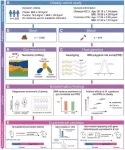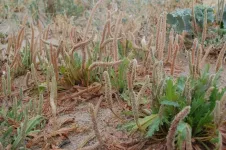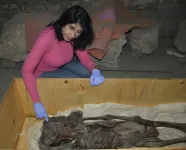(Press-News.org) A recent study published in Cell Host & Microbe identifies a potential obesity-linked bacterium, Megamonas, from a large-scale cohort of obese individuals in China. This research suggests potential strategies for future obesity management by illustrating how the bacterium degrades intestinal myo-inositol, enhances lipid absorption, and contributes to obesity.
The study is jointly conducted by Ruijin Hospital affiliated with Shanghai Jiao Tong University School of Medicine, BGI Research, and BGI Genomics Institute of Intelligent Medical Research (IIMR).
"Through a large-scale study of intestinal metagenome and host genome in obese Chinese, this research reveals a strong link between gut Megamonas and obesity," said Dr. Yang Fangming, co-first author from BGI Genomics. Dr. Yang adds, "The research uncovers the mechanism by which Megamonas induces obesity, providing a new target bacterium for the diagnosis and treatment of obesity."
The researchers performed metagenomic sequencing on fecal samples from 1,005 individuals, including 631 obese individuals and 374 normal-weight individuals, and conducted whole-genome sequencing (WGS) on 814 of these participants. They reveal a strong link between Megamonas and obesity—the combination of Megamonas and host genetic risk factors significantly increased the likelihood of obesity.
In the analysis, comprising both obese and normal-weight participants, metagenomic sequencing showed a notable increase in Megamonas in the intestines of obese individuals. All of the samples were further categorized into three enterotypes based on core genera: Bacteroides, Prevotella, and Megamonas. Individuals with the Megamonas-dominated enterotype had higher BMI and a greater incidence of obesity.
WGS was performed on 814 individuals to explore the influence of Megamonas across various genetic obesity risk backgrounds. The researchers discovered that gut microbial imbalance has a more significant impact on obesity in individuals with low genetic risk. They concluded that Megamonas has an additive effect with host genetics on obesity.
The findings were further supported by animal studies. Megamonas rupellensis significantly increased weight and fat accumulation in mice on a high-fat diet. The bacterium degrades myo-inositol, a compound that effectively inhibits fatty acid transport. Its degradation enhances intestinal fat absorption, leading to obesity.
About Whole Genome Sequencing (WGS)
BGI Genomics’ whole genome sequencing (WGS) service detects the complete genome sequence at one time and provides a high-resolution, base-by-base view of the genome. This enables researchers to see both large and small variants and identify potential causative variants for further follow-on gene expression or regulation mechanism studies.
About BGI Genomics
BGI Genomics, headquartered in Shenzhen, China, is the world's leading integrated solutions provider of precision medicine. Its services cover more than 100 countries and regions, involving more than 2,300 medical institutions and 10,000 employees worldwide. In July 2017, as a subsidiary of BGI Group, BGI Genomics (300676.SZ) officially began trading on the Shenzhen Stock Exchange.
END
Megamonas bacterium found to influence obesity risk
2024-08-02
ELSE PRESS RELEASES FROM THIS DATE:
Scientists find a human “fingerprint” in the upper troposphere’s increasing ozone
2024-08-02
Ozone can be an agent of good or harm, depending on where you find it in the atmosphere. Way up in the stratosphere, the colorless gas shields the Earth from the sun’s harsh ultraviolet rays. But closer to the ground, ozone is a harmful air pollutant that can trigger chronic health problems including chest pain, difficulty breathing, and impaired lung function.
And somewhere in between, in the upper troposphere — the layer of the atmosphere just below the stratosphere, where most aircraft cruise — ozone contributes to warming the planet as a potent greenhouse gas.
There are signs that ozone is continuing to rise in the upper troposphere despite efforts to reduce its ...
Researchers develop promising therapy treatment that can kill glioblastoma cells in newly discovered brain pathway
2024-08-02
A new pathway that is used by cancer cells to infiltrate the brain has been discovered by a team of Canadian and American research groups led by the Singh Lab at McMaster University. The research also reveals a new therapy that shows promise in blocking and killing these tumors.
The research, published in Nature Medicine on Aug. 2, 2024, offers new hope and potential treatments for glioblastoma, the most aggressive form of brain cancer. With existing treatments like surgery, radiation therapy and chemotherapy, the tumors often return, and
patient survival is limited to only a few months. With this new treatment, ...
York researchers make breakthrough in bid to develop vaccines and drugs for neglected tropical disease
2024-08-02
Scientists have developed a new, safe and effective way to infect volunteers with the parasite that causes leishmaniasis and measure the body’s immune response, bringing a vaccine for the neglected tropical disease a step closer.
The breakthrough, by a team from the University of York and Hull York Medical School, is described in the journal Nature Medicine and lays the foundations for vaccine development and for testing new preventative measures.
Controlled human infection studies, where volunteers are exposed to small amounts of ...
Combined effects of plastic pollution and seawater flooding amplify threats to coastal plant species
2024-08-02
Two of the planet’s more pressing environmental stressors have the potential to alter the growth and reproductive output of plants found right along the world’s coastlines, a new study suggests.
The research, published in the journal Environmental Pollution, is one of the first to examine the combined effects of seawater flooding and microplastic pollution on coastal plants.
It showed that both stressors had some effects on the species tested, with microplastics impacting the plants’ reproduction while flooding caused greater tissue death.
However, being exposed to both microplastics ...
Sea level changes shaped early life on Earth, fossil study reveals
2024-08-02
A newly developed timeline of early animal fossils reveals a link between sea levels, changes in marine oxygen, and the appearance of the earliest ancestors of present-day animals.
The study reveals clues into the forces that drove the evolution of the earliest organisms, from which all major animal groups descended.
A team from the University of Edinburgh studied a compilation of rocks and fossils from the so-called Ediacaran-Cambrian interval – a slice of time 580–510 million years ago. This period witnessed an explosion of biodiversity according to fossil records, the causes of which have ...
'Screaming Woman' mummy may have died in agony 3,500 years ago
2024-08-02
In 1935, the Metropolitan Museum of New York led an archaeological expedition to Egypt. In Deir Elbahari near Luxor, the site of ancient Thebes, they excavated the tomb of Senmut, the architect and overseer of royal works – and reputedly, lover – of the famed queen Hatschepsut (1479-1458 BCE). Beneath Senmut's tomb, they found a separate burial chamber for his mother Hat-Nufer and other, unidentified relatives.
Here, they made an uncanny discovery: a wooden coffin holding the mummy of an elderly woman, wearing a black wig and two scarab rings in silver and gold. But what struck the archaeologists was the ...
Healthy AI: Sustainable artificial intelligence for healthcare
2024-08-02
Similar to other sectors around the world, the light speed development of artificial intelligence (AI) has made its way into healthcare, particularly the radiology field. As such, AI-based diagnostic systems are flourishing, with hospitals quickly adopting the technology to assist radiologists. In contrast, there are concerns about the environmental impact of increasingly complex AI models and the need for more sustainable AI solutions.
Therefore, Associate Professor Daiju Ueda of Osaka Metropolitan University’s ...
First full 2-D spectral image of aurora borealis from a hyperspectral camera
2024-08-02
Auroras are natural luminous phenomena caused by the interaction of electrons falling from the sky and the upper atmosphere. Most of the observed light consists of emission lines of neutral or ionized nitrogen and oxygen atoms and molecular emission bands, and the color is determined by the transition energy levels, molecular vibrations and rotations. There is a variety of characteristic colors of auroras, such as green and red, but there are multiple theories about the emission process by which they appear in different types of auroras, and to understand the colors of auroras, the light must be broken down. ...
Turkey vultures fly faster to defy thin air
2024-08-02
Mountain hikes are invigorating. Crisp air and clear views can refresh the soul, but thin air presents an additional challenge for high-altitude birds. ‘All else being equal, bird wings produce less lift in low density air’, says Jonathan Rader from the University of North Carolina (UNC) at Chapel Hill, USA, making it more difficult to remain aloft. Yet this doesn’t seem to put them off. Bar-headed geese, cranes and bar-tailed godwits have recorded altitude records of 6000 m and more. So how do they manage to take to the air when thin air offers ...
Texas A&M professor named to Committee on Rural Health by U.S. Secretary of Health and Human Services
2024-08-01
Dr. Alva O. Ferdinand, head of the Department of Health Policy and Management at the Texas A&M University School of Public Health, has been named to the Health Resources and Services Administration’s National Advisory Committee on Rural Health by U.S. Secretary of Health and Human Services Xavier Becerra. She will serve a four-year term on the committee, which is comprised of nationally recognized rural health experts tasked with providing recommendations on rural health issues.
Since 2019, Ferdinand has served as director of the Southwest Rural Health Research Center, whose research has impacted federal policies nationwide for more than two decades. ...








